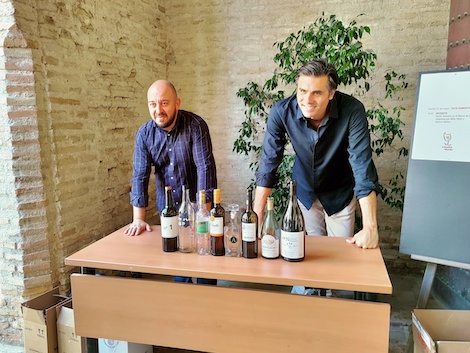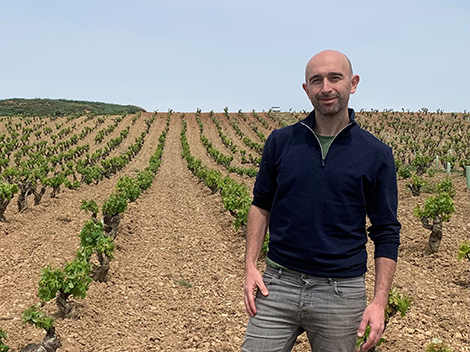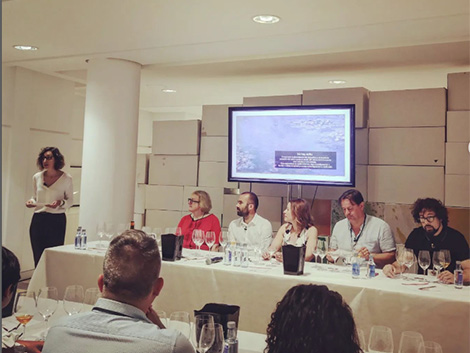The human factor in Sherry and Montilla, by Willy Pérez and Ramiro Ibáñez

"The Rolling Stones never disappoint,” said some people on the last day of Vinoble 2022 on 31 May. It was not a compliment directed at the veteran British band, who were performing the following day in Madrid, but rather at Willy Pérez and Ramiro Ibáñez, who dazzled everyone who managed to get a ticket for their tasting at the Sala Mezquita in the imposing Alcázar of Jerez.
Whereas at Vinoble 2018 they explored the vineyards and soils of Jerez, on this occasion the region's most dynamic duo —whose long-awaited book is still being refined and has no publication date yet— focused on the human factor of the area. They called it "the canon" and presented eight people, all of them misunderstood or rejected but later imitated, who changed the rules of the Sherry game. The common thread were eight wines that provided the context to describe the lives of these men —"hopefully the next addition will include a woman,” Willy told us a few days later— who lived from the 18th century to the present day.
Comparing their trajectories with those of many great artists in history, they talked about the stages prior to the universal recognition of their art, from the initial rejection of the style until it becomes a trend and is universally acclaimed and transmitted. "If you join the trend in the exaltation stage, you will be just any other, if you join in the previous creation stage, you will go down in history," Willy said during the presentation, where he mentioned Peter Sisseck in Ribera del Duero, Álvaro Palacios in Priorat or Raúl Pérez in Bierzo as driving forces behind the changes in the canon in their respective regions.
Simón Rojas Clemente (1777-1827)
With a set of clues for the audience, Willy and Ramiro launched their gustatory canon of the Sherry Triangle with a short biography of Simón Rojas Clemente, "the best ampelographer in Europe,” a discipline that was virtually undeveloped in Spain until the beginning of the 19th century. Persuaded by the adventurer and Arabist Domingo Badía to travel to Morocco for a scientific expedition, which turned out to be an espionage mission for King Charles IV, Rojas Clemente later settled in Cádiz, where he thoroughly explored the province's plants, crops and microclimates.
Encouraged by Francisco de Terán, director of the Botanical Garden of Sanlúcar, a man who, according to Willy and Ramiro, "changed his life and mentality,” Rojas Clemente poured his knowledge into his 1803 essayVariedades de la Vid Común que Vegetan en Andalucía (Common Vine Varieties in Andalusia), where he catalogued and analysed 43 varieties. Ramiro likened the importance of this work to the leap made by DNA analysis today.
While Willy and Ramiro described the adventures of the ampelographer, the audience tasted a concentrated and powerful Amontillado Viejísimo by Rafael Terán, whose origins date back to that time. In those years, criaderas and soleras were being introduced in Sanlúcar and Listán, known among growers for its potential to develop a layer of flor, was the main grape variety. "That was the time when the divergence began between Sanlúcar, with wines born by and for the people, and Jerez, which was struggling to restore its overseas market.”
Pedro Domecq (1787 - 1839)
Willy Pérez's admiration for this Frenchman who settled in the iconic El Majuelo castle in Macharnudo is well-known so Pedro Domecq had to be one of the leading figures in his list of people who transformed Jerez. He took control of the solera’s of his famous uncle, Juan Haurie, in 1822 and went on to become one of the most important firms in Jerez.
"Pedro Domecq imposes the oxidative style of golden wines in El Majuelo, the most famous vineyard in Spain over the past three centuries. He divided Macharnudo into Macharnudo Alto and Macharnudo Bajo, adopted the sober Carthusian style of this pago, resting on a mountain of diatoms, and created a marvellous 200-hectare project there, without forgetting the importance of the estates that settled there around the figure of Domecq: Valdespino, De la Riva, Agustín Blázquez, etc. It is very difficult to find a person who has had such an impact on the flavour of a pago. Macharnudo is a unique style,” Willy concluded.
To showcase that great pago on the palate, our glasses were filled with Harveys Medium VORS, a wine from Fundador's SSP Solera, Pedro Domecq's most direct successor winery. Flavoured with a little Pedro Ximénez, the customary style of the time, it is a fine example of Macharnudo's concentration.
On a final note, Ramiro recalled Domecq's pivotal role in the creation of Jerez's fino style after a conversation with the winegrower and writer James Busby, a connoisseur and drinker of European wines. "Until then Jerez bought pale wines from Sanlúcar or Montilla, but when demand for biologically aged wines grew in Europe, Domecq created a style of fino with more substance than the Sanlúcar pale whites but with less structure than the wines of Montilla.”
Manuel María González Ángel (1812 - 1887)
Despite being the only one of seven brothers who didn't study, the Sanlúcar-born Manuel María Gonzalez Ángel, founder of González Byass, is, in his own right, a universal referent of Jerez's pale style with the famous Tío Pepe solera. "He and Pedro Domecq are the Shakespeare and Cervantes of Jerez, the very core of the canon, two companies that vied for centuries to impose their style," Willy explained.
If Domecq is Macharnudo, González takes his Sanlúcar identity and transforms the personality of Carrascal in Jerez, an inland pago famous for producing fine oxidatively aged and sweet wines. As both producers said, "González seeked finesse in this pago and his imprint is so important that all his neighbours started harvesting earlier trying to follow this new style.”
Unlike the other two, on this occasion it was possible to taste a wine from the bodega founded by Manuel María González. It was a sapid and enveloping Tío Pepe Dos Palmas, a 2018 release from a selection of butts from the second criadera of the fino amontillado solera and aged for an average of eight years.

Domingo Pérez Marín (first half of the 19th century - 1917)
He owned just one vineyard and made a single wine on the Miraflores La Baja pago in Sanlúcar, but his manzanilla La Guita —owned by the Estévez group since 2007— became, in the mid-20th century, the most famous and prestigious brand in the country.
By 1875, when Pérez Marín owned Miraflores, it was common for Manzanilla soleras to have between 15 and 25 criaderas -up to 30, in some cases- in contrast to the style of whites during Rojas Clemente's time, which had just two or three criaderas and were less concentrated and less alcoholic. For Ramiro, "the extraordinary thing about Pérez Marín is that he understands that viticulture does not end in the vineyard but also enters the winery establishing the Miraflores canon".
Miraflores La Baja is not the closest vineyard to the sea -there is a first strip of albariza formed by two pagos, Carrascal de Sanlúcar and Torrebreva, producing lean and fresh but somewhat rustic wines. Despite the pago's location, Pérez Marín made fresh but also fine wines because he understood the need to have many criaderas, and move the wine with regular sacas and rocíos in order to gain elegance and broaden the character of the vineyard. "Domingo created a style that is unique to the coast of Sanlúcar, which at the time was something of a breakthrough. Being such a delicate style, it seemed that the wine would not last in the bottle, but as old bottles of La Guita show, its finesse remains intact over the years.”
Inevitably, the wine we tasted was Manzanilla La Guita, now with its new tall bottle and without the piece of string that has been the image of the bottle since 1908. Thankfully the content remains the same -the grapes come from Miraflores La Baja and are purchased from the Covisan cooperative in Sanlúcar.
José Gabriel Aldama, Count of Aldama (1851 - 1901)
Born into a very religious and righteous family, Aldama inherited his uncle's bodega in Sanlúcar and became a staunch defender of natural manzanillas. At the time, sherry sales and prices plummeted as the wines were said to be adulterated, having sugar and colour added to make them look older, according to a doctor's letter published in the British newspaper The Times in 1873.
Against this background, the region witnessed the emergence of a natural wine movement led by Gumersindo de la Rosa, the Marquis of Casa Domecq and the Count of Aldama, who wrote down his thoughts and vision.
"With the arrival of phylloxera, Aldama stopped producing wine from his vineyard and decided against buying must for five years because he distrusted its quality; he believed that with American rootstocks, the plants would produce higher yields and dilute his criaderas," explained Willy, who also added that Aldama stopped refreshing his soleras for 20 years. "He said that his manzanillas, which were from Maína, were not fortified. Aldama sought concentration, shaping the canon of this pago: sapid wines with concentration and a powerful, almost Jerez-like style.”
To honour this natural wine pioneer, we tasted an Amontillado Viejísimo Conde de Aldama. It rests in a very large cask at Bodegas Argüeso, now owned by Bodegas Yuste, which the Count was said to have sealed with cement to prevent it from being refreshed. That's not the case any more, but the wine is incredibly sapid and powerful, and fits perfectly into the Maína canon.
Francisco de Alvear (1869 - 1959)
A descendant of one of the oldest winemaking families in Spain, Francisco de Alvear introduced the criaderas and soleras system in Montilla, created the amontillado style as a wine to be replicated, and developed viticulture in the area. He also raised the profile of Montilla, a town which until then had been overshadowed by the wines of the more famous Lucena.
"Alvear creates the canon of the sierra de Montilla. He understands that elegance and freshness are in the sierra, an area some 200 metres higher than Moriles. As a result, other producers began to imitate this finesse, which could be compared to the wines of Sanlúcar as opposed to the strength of Moriles, which is more akin to Jerez,” said Ramiro, who added that Alvear fought fervently against phylloxera, planting many vines and paying well for the grapes, thus generating a trend in viticulture that until his arrival was in the minority.
An elegant and fine old amontillado Criadera A, from the Sierra de Montilla, was served. A style that, as Ramiro reminded us, was known until then as montilla in the area and was a very structured white wine that was later imitated in Jerez. "Montilla was always an area of dry wines; sweet PXs did not arrive until the 1920s thanks to the influence of Malaga.”
Manuel Barbadillo (1891 - 1986)
A man of great culture and a forward-looking and innovative attitude, Manuel Barbadillo was always eager to learn. This led him to publish in 1951 El Vino de la Alegría —the most important treatise ever written on manzanilla, according to Ramiro—, as well as books on poetry and the history of Sanlúcar.
This book is contemporary to Jerez-Xeres-Sherry, an encyclopaedic and analytical work written by Manuel María González Gordon. It contrasts with Barbadillo's, written from the heart and looking to the future. "He said that vineyards in Sanlúcar were very fragmented and perhaps lacked some structure; he believed that it was necessary to change things in order to make wines of superior quality. Because of this need to know, in 1933 he harvested and fermented grapes from all the vineyards in Sanlúcar and called the best noses in town to taste and evaluate the wines, something he did again 13 years later,” Ramiro explained. "He wanted wines with more structure but also the finesse of the winery's bespoke suit."
To understand Manuel Barbadillo's thirst for knowledge and inquisitiveness, we were served a still alive Castillo de San Diego 1986, a wine that was the fruit of his constant experimentation. One of the best selling wines in Spain for decades, with it he broke the rules and shook the foundations of the prevailing times. "The winery was sealed for three days and the label was required to explicitly say ’vino no amparado' (unprotected wine). It was a totally transgressive wine".

Eduardo Ojeda
The last creator of a canon in Jerez, who was present in the room, received a heartfelt and public tribute by Ramiro and Willy. "He represents the global vision. He understands the entire Jerez region from end to end. He brings together intelligence, courage, self-criticism, determination, creativity, commitment, dedication, restlessness, generosity and passion. He managed to produce 10,000 butts of a single wine and 12 million bottles, created a team in 2005 and finesse is his premise when it comes to winemaking.”
Ojeda, who worked for large companies like Croft and Estévez, broke the mould with his white wine Navazos-Niepoort, launched in 2008. "It was something different to anything that existed in Jerez at that time; it put the focus on the vineyard and the terroir, but before the success and recognition of the region's white wines, he suffered from rejection and resignation," Willy said. "Right now, Ramiro and I are transmitting the canon and as the next generation we must honour this debt.”
Despite Ojeda's reluctance to speak, the Equipo Navazos member took to the stage, to the resounding and long applause of the room who was tasting the 2018 vintage of Navazos Niepoort in their glasses. "I didn't come here to speak, but I'm thrilled to see myself with these figures. To be honest, I don't feel I belong there. All I have done during my whole life is waking up, go to work and always enjoying myself. And that's all," said a nervous and emotional Ojeda. "Now it's their time," he noted, pointing to Willy and Ramiro.
Our warm thanks to the great sherry photographer, Abel Valdenebro, for kindly sharing some of his photos with us.

Yolanda Ortiz de Arri
A journalist with over 25 years' experience in national and international media. WSET3, wine educator and translator
NEWSLETTER
Join our community of Spanish wine lovers






